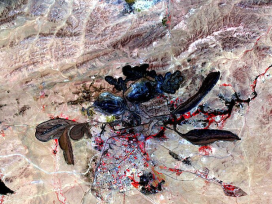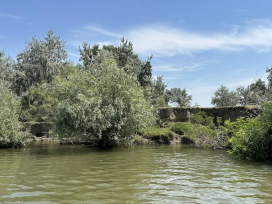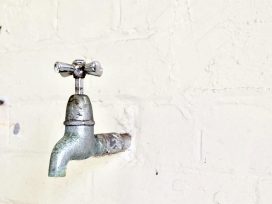To save Europe’s rivers, it’s back to basics
Rivers can be used to combat the risks of flooding or drought, particularly in urban areas. But schemes can impact negatively on the environment and water quality. Opposition to an abstraction system on the Thames throws up the question of natural alternatives.
If you’re a river swimmer in the UK, you learn to check for sewage overflow warnings. Last year, raw discharge was sent into English rivers a whopping 825 times a day. When the coast is clear from the upstream sewage works, locals flock to Teddington Lock, a leisurely stretch of the Thames in West London that’s brimming with rowers, sailors, paddleboarders and swimmers attached to bright tow floats. This is by no means an official swimming spot, but 60 years after being declared ‘biologically dead’, focused recovery efforts mean the Thames is again home to fish, invertebrates, water birds, marine mammals, as well as people. Teddington Riverside has become a beloved place for Londoners to connect with their river.
But maybe not for much longer. ‘London needs to sort itself out in terms of drought resilience, and we support that. But there are better alternatives,’ says Magnus Grimond, a river swimmer and activist with Save Ham Lands & River, which is campaigning against Thames Water’s plans to abstract large quantities of river water at Teddington. The problem is that the water will be replaced with treated sewage effluent, and protesters are worried about what this will do to the health of the river and everything in it. As drought reduces river flow, the effluent will make up a notable proportion of the water – this is worrying in light of the difficulty in removing hormones, pharmaceuticals and PFAS, the so-called ‘forever chemicals’.
‘This scheme would provide up to 75 million litres of water a day, but that’s a tiny fraction of what Thames Water loses,’ says Grimond – old, leaky pipes claim 630 million litres a day, but Thames Water is decades out from getting a handle on their leaks. The plans will also lay waste to a local nature reserve, says Grimond: ‘Put your own house in order before you start trashing the urban idyll!’ (Thames Water did not respond to requests for comment.)
A difficult balance
As the problem of climate change intensifies, cities need to become more drought-resilient. Thames Water’s plan, which will be finalised next year, is one of the cheaper and quicker solutions. But is it the right approach? ‘Any water recycling option considered by water companies must meet clear environmental requirements,’ said a spokesperson for the UK Environment Agency, which has already rejected more ambitious water abstraction plans from Thames Water due to the environmental impacts. ‘We will be scrutinising the detailed proposals in the coming months.’
The situation in London foreshadows some of the difficulties that lie ahead: water will become an increasingly precious resource, and we will need to balance the needs of people, wildlife, and nature. Across Europe, focused efforts to improve wastewater treatment and pollution from industry means rivers are cleaner than in recent decades, and the result is improvements in quality of life. But heatwaves, droughts and floods are bringing a new level of emergency to the need for water management across the continent.
About three-quarters of Europe’s population lives in cities and urban areas – access to a healthy river to cool off is increasingly important as heatwaves increase in frequency. Beyond leisure, European rivers are central to the EU’s goal to cut transport emissions by 90 per cent by 2050, which include plans to move cargo off the roads and onto the waterways. But when drought lowers water levels, as happened in 2022 along the Rhine in Germany, the result is not only major economic disruption, but it also throws a spanner in the works for climate targets. Global warming means this problem is likely to worsen: research from University College London found that a 1-3°C increase in temperatures would reduce the water flow in 321 of the world’s biggest river basins.
Sharper focus on water quality
Low water volumes bring other problems. Take the 2022 Oder disaster in Poland, where low volumes in combination with warmer temperatures and pollution created perfect conditions for a toxin-producing algae, resulting in the deaths of hundreds of tonnes of fish. ‘In recent years, our understanding of water pollution has deepened,’ says Caroline Whalley, an expert on water industries and pollution with the European Environment Agency (EEA). ‘Ensuring there is sufficient and equitable water for the environment, public supply, agriculture and industry is looking to become a major challenge as climate change impacts water resources,’ adds Whalley, pointing to how this is being addressed in the European Commission’s proposed revisions to the Urban Waste Water Treatment Directive, which calls for reduced pollution, emissions and energy use.
During droughts, low water flow means contaminants cannot be diluted, while in times of excess rain and flood, more contaminants run into the river. These currents of contamination put both ecosystems and human access to safe water under threat. ‘We can have a situation where there’s enough water for nature, people and irrigation, but the water quality is insufficient,’ says Nynke Hofstra, associate professor in the Water Systems and Global Change Group at Wageningen University in the Netherlands and co-author of a recent study on water quality. ‘For example, if the water in the river is too warm, it cannot cool a power plant. Or if the water has a lot of heavy chemicals, cleaning it for drinking will take a lot more effort.’
Hofstra calls for more comprehensive models for monitoring water quality: ‘There’s a direct link between temperature, precipitation change, and flow in the river. But for water quality, the relation is often more indirect.’ A better understanding of sources, spatial patterns of water quality, and the impact and future trends would enable us to properly assess the consequences of climate change: ‘We could say, for example, how many more people become ill [from] waterborne diseases due to climate change, or how many more people are affected by salinity,’ says Hofstra.
Restoring the natural shape of the river
Today, only 40 per cent of Europe’s rivers, lakes and groundwaters are estimated to be in good condition, putting us far short of the EU’s Water Framework Directive goal to reach 100 per cent by 2027. ‘It’s an ambitious piece of law that looks at water in a holistic way, … but it’s not very well implemented and enforced,’ says Claire Baffert, senior water policy officer at the WWF European Policy Office. The WWF chairs Living Rivers Europe, a coalition of six European NGOs set up to promote the application of the Water Framework Directive. ‘It looks at the chemical status of the water. It looks at the ecological status – what kind of species you find? What does the river look like, are the river banks artificialised? It also looks at the amount and quality of groundwaters in the aquifers.’
Beyond agriculture, Baffert says the main pressures on European rivers are alterations to their shape and flow from infrastructure – hydropower, flood defence and navigation features such as dams and dykes. ‘There are more than one million river barriers in Europe, many of them small, and about 10 per cent no longer serve a purpose but are still major obstacles to things like fish passage and sediment transport. They seriously impair the river’s natural functions,’ says Baffert. Living Rivers Europe is advocating for restoring rivers so they can play a natural role as buffers against floods or water scarcity: ‘When a river flows naturally … it’s connected to its floodplains, [and] can expand laterally when there is flooding. You can avoid a lot of the damages just by allowing those floodplains to play their natural role as sponges.’
Until now, we’ve relied heavily on engineering to combat flooding, but climate change means it’s no longer enough. This much was clear in Greece in early September, where rivers have been heavily regulated for agriculture: ‘Greece still had massive [destructive] floods, showing that infrastructure is no longer a solid protection,’ says Baffert. She points to how, after flooding of the Elbe in Germany caused major casualties in 2002, WWF Germany worked with the government to move dykes and restore the natural riverbank. ‘This is expected to reduce the flood stage by up to 30 centimetres over an area of several kilometres – this is significant impact,’ says Baffert, adding that by allowing the river to expand, water can be stored in the ground again and this becomes a defence against drought.
The power of taking action
Back in the UK, a small tributary has been causing problems in its North London neighbourhood, where increasing urbanisation means the water has nowhere to go during heavy rains. While 1,000 homes are at risk, this is nothing like the biggest flooding disasters across Europe. But for local residents, Action for Silk Stream presents an opportunity to take action where they live, and help fix the problem one riverbank at a time.
‘This is a natural flood management programme. We ask [locals] to help by creating new wetlands, or doing simple things like clearing brambles,’ says Liz Gyekye, communications manager at Thames21, the campaign group that co-runs Action for Silk Stream and many other river restoration efforts around London. The Silk Stream project is part of a 150 million pounds flood resilience programme from the UK Environment Agency, and the local councils are doing their part by bringing the heavy machinery as the campaign works to restore the natural shape of the Silk Stream. For Thames21 it’s important to bring locals along in the work, says Gyekye: ‘Climate change can be overwhelming, but when you’re there and see it with your own eyes, you can feel like you’re doing your small part. It’s a tangible achievement.’
Faced with life-threatening floods and destructive droughts, a swimmable river may seem like a lower priority. But if you can swim in the river, it means it’s clean. Today, 85 per cent of official European bathing sites have excellent water quality, thanks to decades of mandated improvements in urban wastewater treatment and tighter controls on pesticides and fertilisers. This figure only refers to Europe’s 22,000 official bathing sites; many major rivers, including the Thames, are not designated for swimming. But several European cities, such as Berlin, Budapest, Vienna, Munich and Basel now officially have swimmable rivers. ‘Urban waters where it is safe to bathe are an increasingly important asset for European cities. It provides opportunities for sport and leisure, with potential direct health benefits,’ says Francesco Mundo, an expert on freshwater data and information at the EEA. ‘Maintaining high quality in urban waters also brings wider socio-economic and environmental benefits, [and improves] quality of life.’
The unique perspective from the river
Right now, years of stormwater management work is coming to a close in Paris, lifting a 100-year-long ban on swimming in the Seine ahead of the 2024 Olympics. After events in three disciplines – the swimming marathon, and the swimming legs of the two triathlons – are held in the Seine, a key legacy of the Olympics will be for Parisians to once again be able to safely swim in their river.
To be able to swim in your city’s river can be a powerful experience. Magnus Grimond is excited for Parisians who will soon get to commune with the Seine, just like he does with the Thames. Seeing the Thames at eye level gives you a unique vantage point, says Grimond: ‘Swimming in the river is like nothing else. It’s a magical experience, and feels like being out in the countryside.’ Grimond’s swimming group has over 1,000 members, and the group has started discussing moving further upstream to avoid the sewage effluent if the day comes – nearly 27,000 people have signed the petition against the water company’s plans, and the debate is heating up.
The Thames Water region would not be resilient to a 1-in-200 year drought – this is a fact. The campaigners are rooting for plans to speed up the repairs of water pipes to stem the leaks, and to build a new reservoir. But that won’t be ready until 2040, and we’ll have a lot of heatwaves before then. Something needs to be done to prepare for that, but what? Thames swimmers are still getting out their tow floats on a daily basis – you can spot them as far into central London as Putney (after which point it’s prohibited). It’s a bittersweet irony to think that most Londoners still think the Thames is too dirty to swim in, because soon enough, they may be right.
This article is published with the support of the European Parliament to the Green European Foundation.
Published 6 November 2023
Original in English
First published by Green European Journal / Eurozine
Contributed by Green European Journal © Jessica Furseth / Green European Journal / Eurozine
PDF/PRINTIn collaboration with
In focal points
Newsletter
Subscribe to know what’s worth thinking about.
Related Articles

Excitement over ‘rare’ elements
Julie Klinger in conversation with Misha Glenny
The race for green transition supplies is on. But where’s the thrill in metals, discreet and hidden yet widespread? Mining, intensive due to low concentrations, throws up waste elements like arsenic. Space cowboys and deep-sea dredgers contest environmental stability more than China’s monopoly, based on 40-years of involved processing. Health and recycling regulations are a must.

The Danube Delta is a remarkable ecosystem on the border of Ukraine and Romania. The Russian invasion against Ukraine, and the subsequent increase in naval traffic threaten this nature reserve, but people on both sides of the border are working to protect the area.






